Blog 10 – Course Reflection
In Blog 1, I expected to learn about the social aspects of people and why we do what we do and are attracted to the people we are; I personally feel that I did achieve that expectation. I also hoped to gain a full range of knowledge about social psychology to take with me into my future career in the psychological field, and I think I am going to leave this course with much more psychological knowledge to take with me in my future career than I previously had. I feel that I have a very good base knowledge of the subjects discussed in the course, but I was obviously not going to be able to learn the entire scope of knowledge that is social psychology in one semester of class. My attitudes about social psychology have changed for some of the topics because they introduced me to knowledge that I may have never accessed without this class; however, my stance on mating and evolutionary psychology hasn’t changed much from what it was prior to the course because I still believe that these are traits that we have evolved far beyond needing (aka using deception about emotional vulnerability to get someone to sleep with you).
If I took this class again, I would prepare myself much better at the beginning of the semester for the workload that came with the class. I would have to work on procrastination and organizational issues. I have grown academically in the last few months by being exposed to the struggles of having to balance working, going to school full time, and having a personal life that is constantly throwing curveballs. I have learned to allow myself a little bit of grace when it comes to unforeseen emergencies, and to tighten up when I am behind and need to pull myself back together. This course accentuated the knowledge I already had about the effect that good deeds and kindness have, not only on other people but on the person performing the deed. I knew this already, like other things in the class that had been mentioned in my high school psychology class, but this course allowed me the experience of witnessing it firsthand through both my actions and listening to the actions of other students in the class. This will help me in my professional life by making me continue to be aware of how my words and actions can impact other people; I will be able to use my emotional intelligence skills to read and respond to others’ emotions.

I included this image as a visual of my academic growth throughout this semester and this course. I have grown significantly and now have more skills than I had before, but I still have plenty of growing and getting better to do. I will never have all of the knowledge in the world, but this course has helped me to gain valuable knowledge about people and how we react to things in the world.
Blog 9 – Top 3
The top three concepts that I learned the most from the ePortfolio assignments are love styles, emotional intelligence, and self-efficacy. In the assignment 3 activity takeaway, we had to take a survey to find out our individual love styles. In Blog 2, we were tasked with learning the difference between emotional intelligence and self-regulation. Emotional intelligence refers to the ability to identify emotions and know how to deal with them in a healthy way; also the ability to recognize and respond accordingly to other people’s emotions. Self-regulation refers to the ability to control one’s own emotions and responses. I found that they are linked because the ability to regulate and stabilize emotions makes it much easier to calm down and choose how to respond to strong and hard emotions.
My second favorite thing that we learned about was love styles in assignment 4. We were tasked with taking a survey that tested seven elements to find our love styles: eros, ludus, agape, storge, pragma, and mania. Eros refers to strong physical preferences, fast attraction, and intense emotions. Ludus refers to love as a game of deception and manipulation. Storge refers to the combination of love and friendship. Pragma refers to a rational calculation with a focus on desired attributes of lovers; also called love planning. Mania refers to symptom love based on the uncertainty of the self or the lover. Agape refers to an all-giving, non-demanding love. From this activity, I learned that every person has their very own individual score in each of the elements. My third favorite thing that we learned about was self-efficacy. We were tasked with taking a generalized self-efficacy test; this test had a score range from 10 (1.0) to 40 (4.0) calculated by finding the sum of all answers. I scored a 3.0 on the test because I am very intelligent, but I tend to procrastinate and have bad time management and organization issues.
There are many connections that can be made from other material studied in the class, but there are two main ones I want to point out. Archive 5 about self and other enhancements can be linked with emotional intelligence because you have to have the good emotional intelligence to be able to read and understand what others are feeling and how you should respond based on the different circumstances. Archive 8 can be linked with the assignment takeaway for heuristics because the archive was based on stereotypes, which occur based on our subconscious biases caused by heuristics. Some of the things we have learned about in this course have crossed over to my English Composition course when we were talking about the credibility of sources in Blog 5. We did the module for Blog 5 before talking about it in English, so doing this blog made it significantly easier for me to tell apart which advertisements and sources are credible or not.
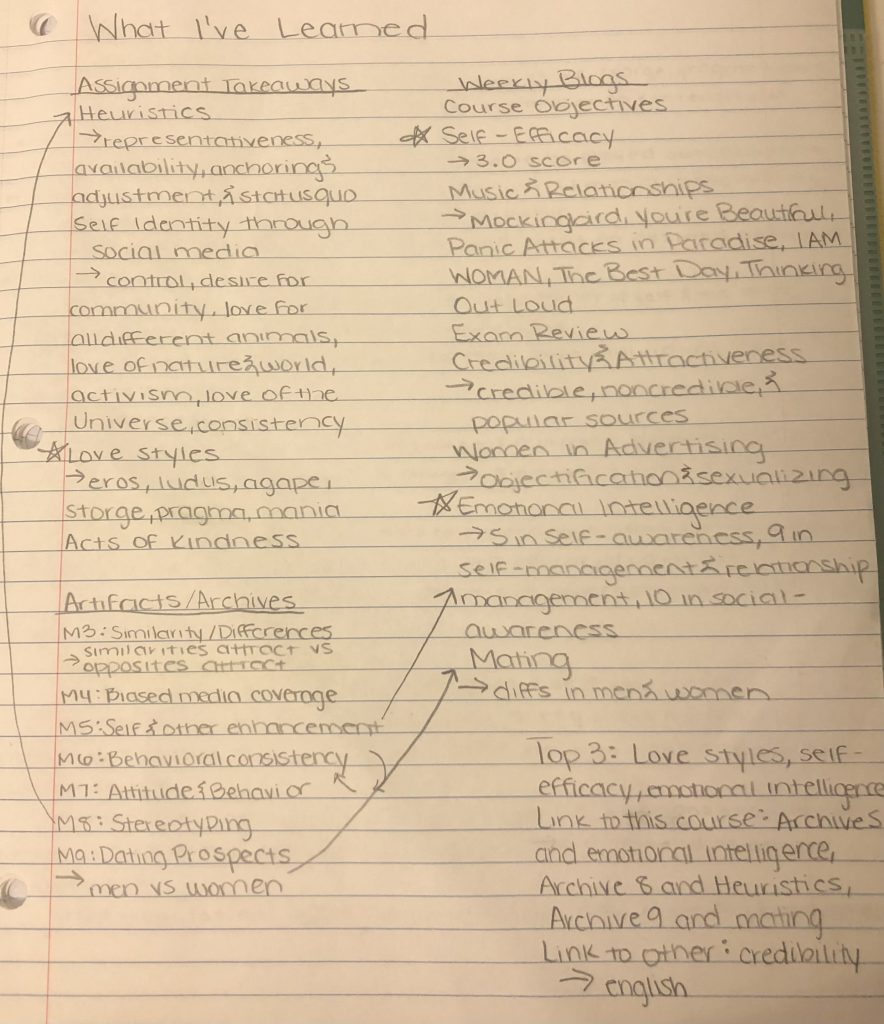
I included this visual as a representation of the process I took to choose the top 3 things we learned about in this course, how to link them to other things in the course, and how to link something to another subject. I used stars to mark the topics I would be using as my top three and arrows to connect the links between different materials in the course.
Blog 8 – Mating
After reading this article about mating, it only slightly changed my prior thoughts on the topic; the article states that there are extreme genetic differences in mating processes and interests. I feel that there is some truth in the ways we have evolved influencing our subconscious actions, but it seems to be a cop-out for bad and ingenuine behavior. The article states that men may pretend to be emotionally involved to increase their likelihood of having sex (71% men, 39% women), while women will send sexual signals to increase their likelihood of gaining nonsexual resources (5x more likely than men). These actions may be influenced by our evolutionary genetic makeup due to the fact that while we were in the earlier stages of evolution, we had a much more dire need to repopulate; this would be “good” reason to feign interest in someone to increase the odds of mating. But we have evolved past the need to lie and deceive someone we are interested in as a way to get what we want. Using evolutionary psychology to justify bad and hurtful actions doesn’t seem okay to me.
On the slides included in the article, the teacher would ask students what are ways men made women upset and what ways women made men upset. It didn’t include any answers in the article, so I thought of my own, asked my mom and some other friends, and looked up articles answering the two questions. I found that a lot of the things that made women upset were emotional/mental and they seemed to be very similar to the ones that made men upset; for example, women get upset when men aren’t emotionally open and vulnerable, while men get upset when women give/expect emotional vulnerability. The list for women was mainly about emotionality, honesty, acts of service/love, and being looked at/treated as a sexual object (this includes lying/being nice as a way to get the woman to have sex with them). The list for men was mainly about feeling forced to do things (marriage, ultimatums, changing, being open).
How Men Anger Women

Men anger women by not being emotionally vulnerable or open. Shutting women out was one of the things I found the most in my search to answer the question “How do men upset women?” This is because women tend to value emotional connection more than sexual connection.
How Women Anger Men

Women anger men by expecting emotional vulnerability. This was one of the main answers I got when trying to find the answer to the question, “How do women upset men?” This is because men tend to value sexual and physical connection more than emotional/mental and don’t like feeling forced into emotional openness. This plays into the gender roles/stereotypes that say that men aren’t supposed to be emotional, they’re supposed to be strong and keep all of their feelings to themselves.
Blog 7 – Emotional Intelligence (EI/EQ)
Self-regulation is related to emotional intelligence in the way that when you can regulate and stabilize your own emotions, it makes it easier for you to calm down and choose how you respond to strong, hard emotions. Without the ability to stabilize your emotions while a hard situation comes up, leading to emotion-based, possibly bad decisions. Being able to identify emotions and control them is crucial to understanding how to deal with the emotions and decide what choices to make. In my opinion, emotional intelligence refers to one’s ability to both identify emotions and know how to deal with them in a healthy way; it also refers to your ability to recognize and respond to others’ emotions. I display emotional intelligence by taking time to identify the emotions I am feeling, and then taking the time to manage and healthily respond to each one. I also spend a lot of time listening to and recognizing others’ emotions, that way I am able to respond and react in a healthy, safe manner. For example, I take the time to read others’ emotions when they enter a room or are talking to me, that way I am able to respond in a conscious, respectful way to both the words they’re saying and the emotions they are displaying.
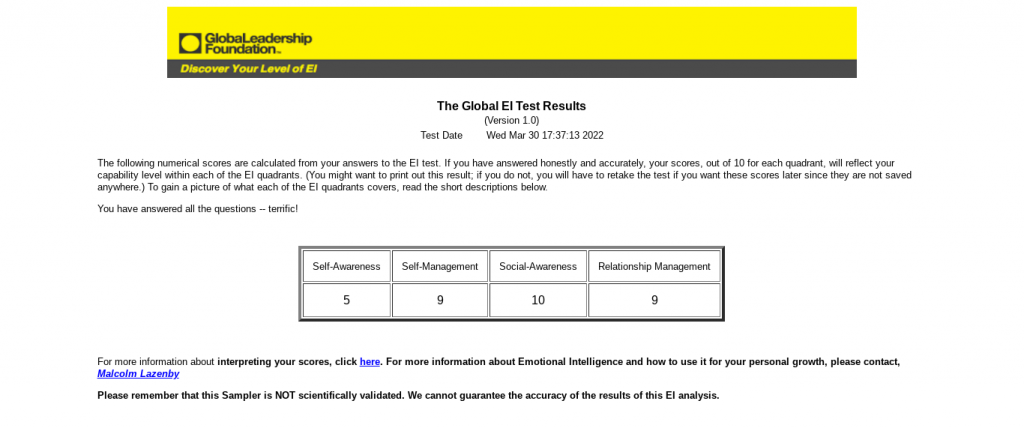
I included this image of my EQ test results because it shows the levels of different aspects of my emotional intelligence. I display a high level in self-management (9), social-awareness (10), and relationship management (9); however, I scored a 5 in the self-awareness aspect. I believe this is because I do better at recognizing and responding to others’ emotions than my own; this is often because other people’s emotions are easier to deal with and help with than my own when I am going through different obstacles because those are personal and therefore feel much bigger. To quickly break down the different aspects of my test results, I do well with self-control, transparency in terms of honesty and integrity, adaptability, achievement orientation, and initiative (self-management). I feel that I can get better in the initiative category by working to find the correct ways for me to operate that will lead to more drive to succeed, which I have, but it can be drowned out by outside circumstances and mental illness (environmental changes and depression/anxiety). I do well with empathy, organizational awareness, and service orientation (social-awareness); this means I do exceptionally well when helping other people, both directly and indirectly. I also do well in visionary leadership, helping develop others, influencing others, being a catalyst for change and new ideas, conflict management, building bonds, and teamwork/collaboration. I think that I can get better in both building bonds and teamwork/collaboration; I struggle with building bonds with new people because of the trauma I have from previous friendships, which influences the ways in which I am able to connect with others.
Blog 6 – Women in Advertisements
My reaction wasn’t super surprised because I educate myself excessively on the treatment and objectification of women in media and the world in general, but she included several things that I hadn’t seen or been as aware of. I was already aware of the way that advertisements tear women down to sell their products, but I hadn’t seen the extent that ads have gone to as a way to tear down and dehumanize women to sell products that don’t even have anything to do with the part they were tearing down (for example, the advertisement that was tearing down women’s breasts to sell hair products – completely unrelated). I adore the fact that she connected these types of advertisements with the normalization of objectifying and even harming women in real life because of the way they portray women as objects instead of people. I really love the quote from the video where she said, “And women live in a world defined by that threat, whereas men, simply, do not.” I have noticed very many times that ads distort the reality of what women look and act like, along with stereotyping every woman as being one way (typically airheads, rude and “bitchy,” or people-pleasing and appeasing). There is a considerable amount of dehumanization of women in advertisements and media as a whole. Manipulation and playing off of people, mainly women, and their insecurities are two of the main tactics in advertising for products like skin and hair care, exercise equipment, and products, clothing, food, and pretty much every advertisement directed to women.

I chose these images as representative visuals for of things mentioned in the video; the first one is describing the shape that girls should take and saying that a pear is not the shape for a girl. It is supporting the beauty standard for women in the United States. The second image is a Dolce & Gabbana advertisement where four men are standing/laying over one woman; this image shows the continued sexualization of women. The third image is one of Pamela Anderson modelling for a PETA advertisement where she has her body parts labelled and the words “All animals have the same parts;” this image shows the objectification and borderline degradation of women in the world. It follows the same format as science posters of different animals, reducing her down to just her body parts and not her as a human being. The fourth image (bottom left corner) has a woman holding a bottle of ketchup with the caption, “You mean a woman can open it?”; this image is demeaning women and labeling them as stupid, and saying that the product is easy enough to use that even a woman could open it. The fifth image (bottom right corner) is, in my opinion, one of the most dangerous and shocking advertisements that I found. It shows a man sitting in a chair with a woman across his lap, and he is about to hit her; the caption talks about if your husband finds out that you aren’t checking for fresher coffee, that he will harm you. It is showing the aggression and abuse women face, and the normalization of it.
Blog 5 – Credibility and Attractiveness
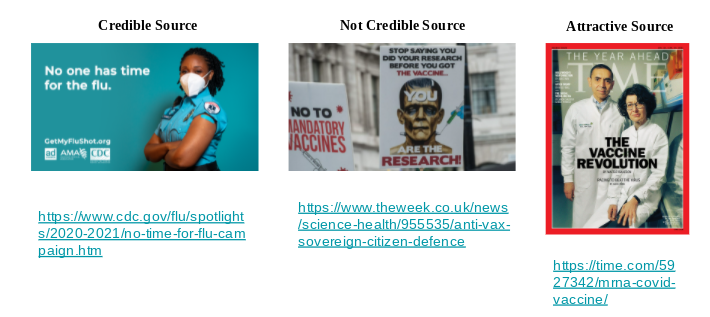
Credibility is based on the perception and attractiveness of the source. All three of the sources that I found focused on vaccines, both flu, and COVID-19 vaccines to be specific. The first image, the credible source, was posted by the Center for Disease Control (CDC), a group that studies diseases and viruses. They are perceived as credible because of their expertise in the area of viruses and vaccines, along with the fact that the advertisement has multiple endorsements for the information provided. The second image, the not credible source, is a sign appearing to be made by someone with no expertise in the matter of vaccines. It has no endorsements or scientific backing on the poster, just claims about being part of the research on the COVID-19 vaccine’s effectiveness. The last image, the attractive source, was posted by TIME magazine, which is a very popular magazine that a lot of people read. The front of the magazine has two doctors and/or scientists supporting the vaccine.
Blog 4 – Exam Review
For the exam review, I looked at my answers for all of the questions and realized I only missed two questions. I put those two questions, my answer for them, and a space for the correct answer in the document with the blog instructions. Both of the questions I missed were blatantly obvious to me after I reviewed them; I missed one question relating to cognition that I realized was a complete misinterpretation from me. I misread the question and felt really confident about the answer, but when I went back and looked for it both in the book and online, I quickly realized my misinterpretation. The second question I missed honestly aggravated me that I missed it; it related to deception.
I learned that I should go back and reread questions multiple times before submitting an exam if time allows. If I would have fully reread the two questions that I missed, I would have caught my obvious errors. I went through my notes and the textbook while trying to find the correct answers to the two questions and that did help me to understand the problems I had during the exam. I reviewed two to three days before the test because I had work almost every day of the week prior to the test; this made it very difficult to be able to dedicate time to studying, but once I did, I think it did help to look over the review sheet. I think this feedback will help my test-taking strategies on future tests because it was just another reminder that looking over my tests carefully can keep me from making very simple mistakes. I will be more consistent about reading over my answers carefully on future tests.

I chose this meme because it describes how I felt when I realized the simple mistakes I made on the two questions I missed. I was a little upset with myself for not looking over my answers again, but I am still happy with the grade I got so I shouldn’t beat myself up over two questions. This was a learning opportunity to make sure I go back and reread the test questions and my answers before submitting the next test.
Blog 3 – Music and Relationships
Music is one of the main ways that humans express themselves, making each song unique to the person and genre. I think that the reason music impacts/affects relationships is that you’re choosing to share an interest that, to some, can be very personal. Music causes a significant increase in hormones like serotonin and dopamine, making people feel happy when they listen to songs that they like. The driving force in the evolution of music is attraction, meaning that there is an obvious link between music and relationships. I have noticed a similarity in the music preferences of mom and sibling, my boyfriend, and my close friends. My mom, sibling, and I all listen to country music together because that is what my mom played around us when we were younger, so now we listen to it out of familiarity. My sibling and I also share a different music taste, where we both enjoy listening to alternative music and more modern, feminist music. My sibling and I also share very similar values. I have similar musical interests with my boyfriend as well, but we also enjoy music that the other doesn’t; for example, when we are in the car, we listen to music that the other likes and frequently add music to our own playlists from the others. Our values are also very similar, as we have grown together as a couple, we have established a relatively stable value system that we both agree on.
As a way to show how music and relationships are connected, below is a playlist of six songs that I relate to a person and/or event:
- Eminem – Mockingbird

I lost my dad when I was 13 and we used to listen to Eminem together all the time. Once I lost him, this song began to take on a new meaning for me. To me, it means that he will always be there for me in spirit, even though he isn’t here in person anymore.
2. James Blunt – You’re Beautiful

This song also speaks to my relationship with my dad, but not as much of the words itself, more about the memory associated with it. The last time I saw my dad, we danced together to this song, and now it means reminds me of that last memory with him. When I listen to it, I feel that he is reminding me of my beauty and how much he loved me.
3. Ashnikko – Panic Attacks in Paradise
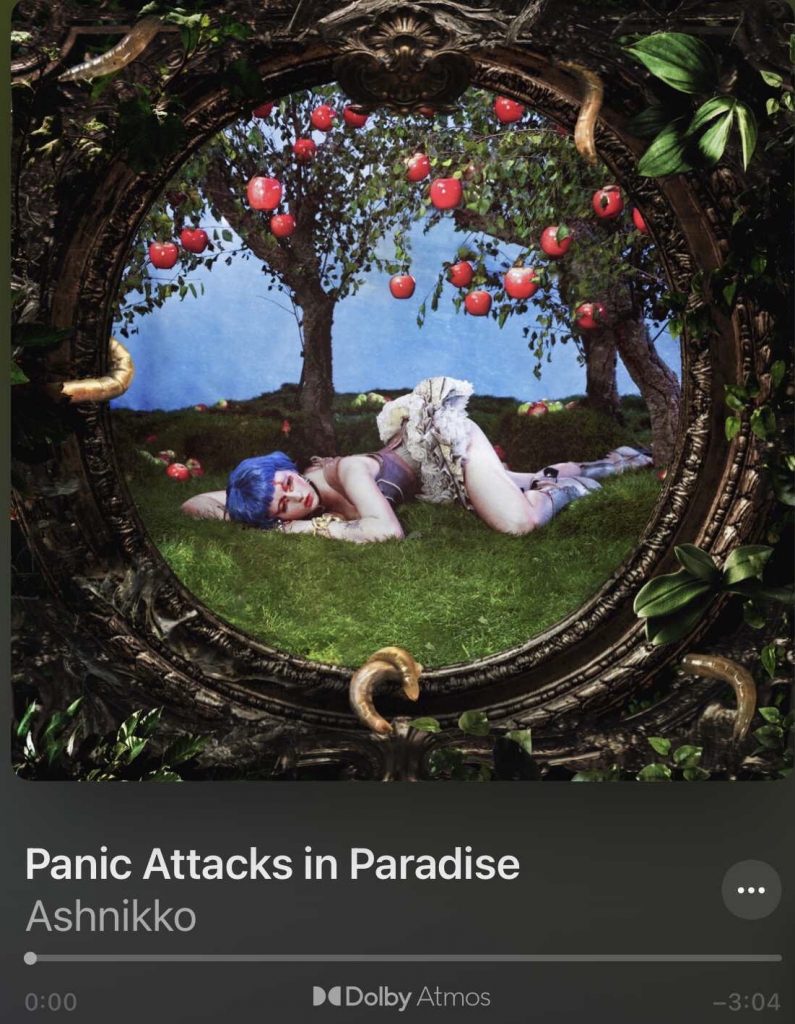
This song speaks about anxiety and panic attacks, and about how hard it is to allow yourself to be happy when dealing with these mental illnesses. I feel that it summarizes how I personally feel about my own anxiety.
4. Emmy Meli – I AM WOMAN

This song is full of affirmations about the power and beauty of being a woman. I play this song when I do not feel the best about myself, and it is immediately uplifting. This song is beautiful and I associate it with myself, my mother, and my sibling.
5. Taylor Swift – The Best Day
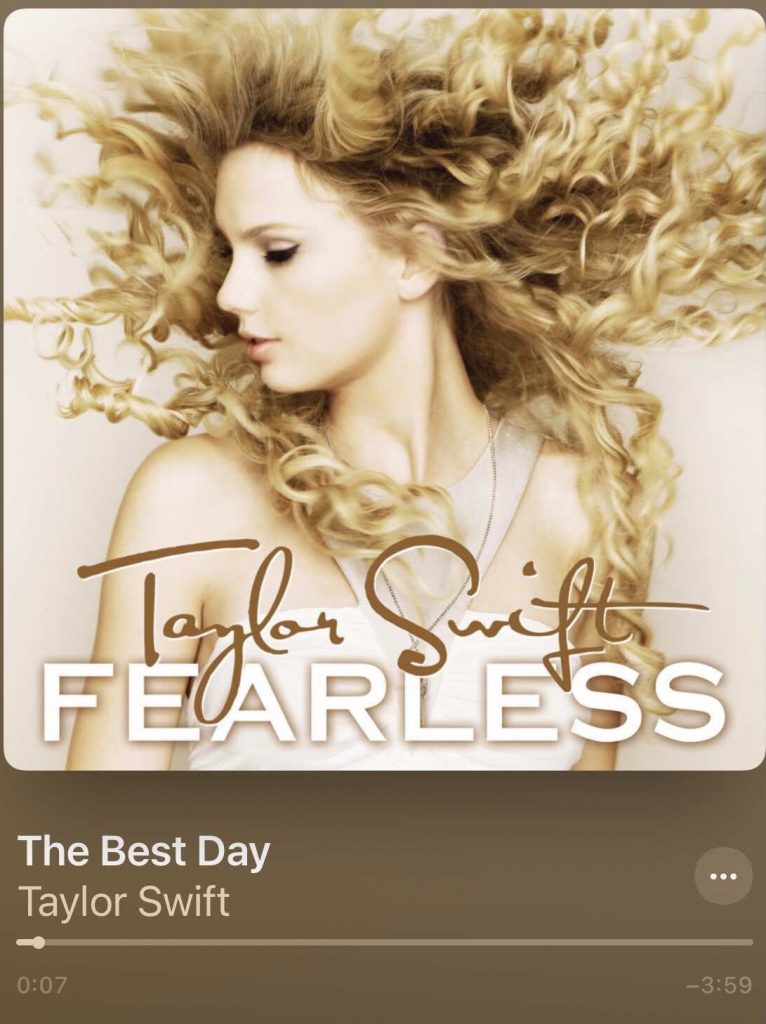
I have been listening to Taylor Swift since I was very young, and this song reminds me of my childhood and the extremely close relationship I’ve always had with my mom. As I’ve gotten older, it has an even deeper meaning because I understand the change from child to adult and how hard it is to grasp that.
6.

This song is associated with my boyfriend as it was the first song we listened and danced together to. We have been together for over four years now, and the song has continued to be very symbolic of our relationship.
Blog 2 – Self-Efficacy
I think I am a pretty good and dedicated student. I feel this way because I have always done extremely well in almost every subject, and the ones that I struggled with, I still overcame and usually received an A or B grade. I feel that I am extremely curious and knowledgeable, I always want to learn more about a variety of topics. This intense curiosity and willingness to learn is why I am slightly confident about myself as a student. I have some reservations about saying I am extremely confident because I have a tendency to procrastinate and that isn’t a typical trait of a good, confident student. Other than this, I feel that I am a very good student with an exceptional work ethic. My self-efficacy score was a 3.0, which demonstrates my skill but also that reservation due to my procrastination. My score is on the higher end of the scale, only one full point away from a perfect 4.0 score. I believe that if I work on my procrastination, time management, and organization, my confidence in myself as a student would be able to reach closer to 4.0 on the scale.
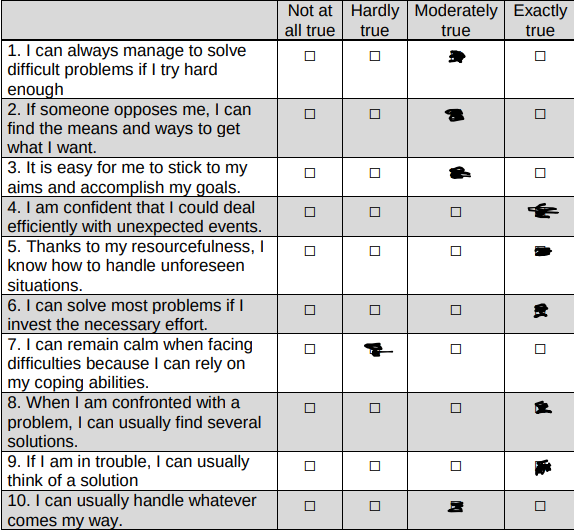
My self-efficacy test results are pictured above. I chose this picture because I feel that these results really helped me to understand my confidence in myself more academically. I have always had a problem with self-doubt, and school was almost always at the top of that “self-doubt list.” It is really easy to let singular grades and surveys like this bother me and increase that self-doubt. I like to remind myself that one single grade in a course is not going to ruin my chances at a good future, nor will survey results that may not be as high as I want them to be. The same goes for my GPA – focusing on school is obviously very important, but allowing a GPA – which is flexible and has the possibility of rising – to fully determine how I feel about myself entirely is not only not healthy, but it does nothing positive for me academically. These questions on this survey helped me to understand what aspects of myself I need to change/fix to be more academically confident and to be an overall better student.
Blog 1 – Course Objectives
The course objectives are meant to explain the basics of Social Psychology through procedures to test behavioral hypotheses, processes of understanding each other, attitude formations and changes, the origins/effects of prejudice and discrimination, and the factors influencing our attraction to people. These objectives – specifically the procedures to test behavioral hypotheses, the processes that people use to perceive and understand others, and attitude formations and changes – will be very relevant in both my personal and professional lives. I will be able to be much more aware in my relationships both platonically and romantically; I will know more about the social aspects of myself and the people around me. I expect to learn about the social aspects of people and why we do what we do and are attracted to the people we are. I hope to gain a full range of knowledge about social psychology to take with me into my future career in the psychological field. I plan to complete all of my assignments while being fulling engaged in the lessons we have – I plan to take detailed notes about each subject where I include both the information provided by my professor and personal and/or real life examples of each concept.

“Systematic Observation”
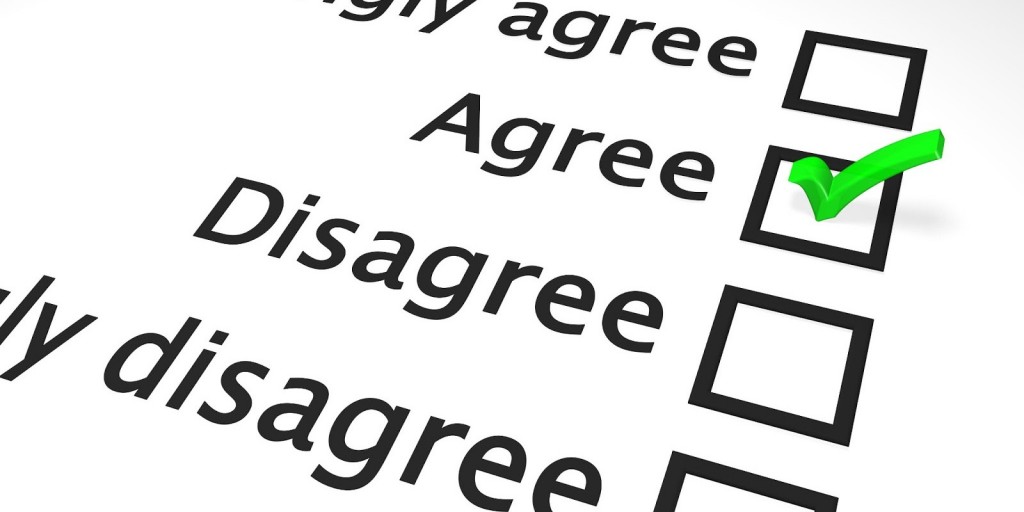
“Survey Method”
I chose these pictures to represent research methods frequently used in social psychology – systematic observation and surveys. Systematic observation refers to watching behavior as it happens and its basically like really careful, secretive people watching – the example used in our text is watching people in a mall to see how many times they touch others in that setting. An example I thought of was when my high school psychology class went around the school hallways and recorded how many people were in the hallways and what they were doing; we did this to see how frequently we saw the same people and how many people were doing things they weren’t supposed to do. We had to do this very inconspicuously by pretending that we were just going to class, the bathroom, etc. Surveys are frequently used in psychological research because they can gather a lot of information from a lot of people at once. I chose these pictures because the first one is a person watching others in a mall and recording what they see – this may not be true but it appears to be what he is doing – and the second photo is a survey to be completed to see what an individual agrees and disagrees with.